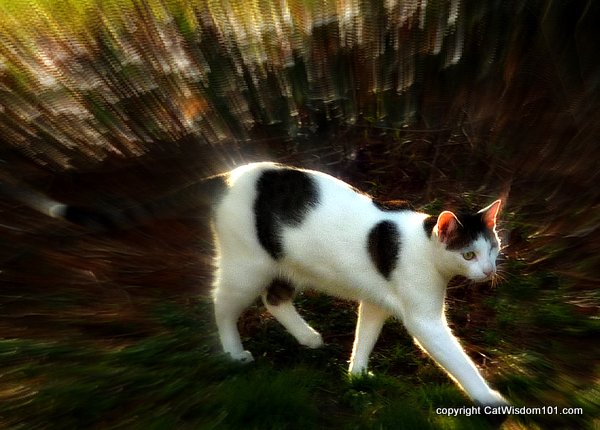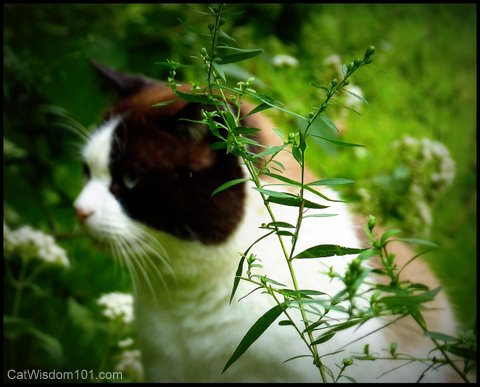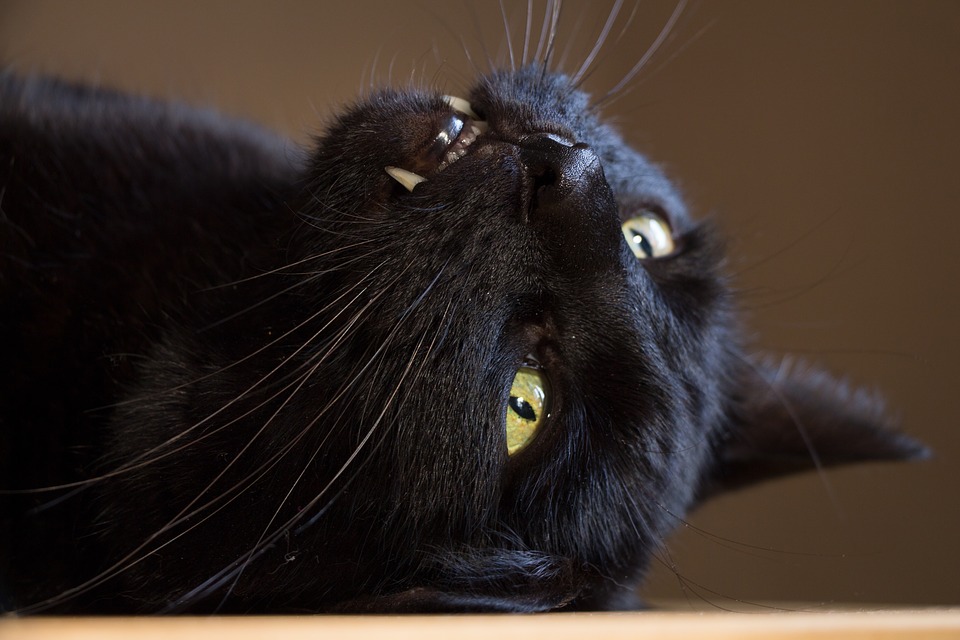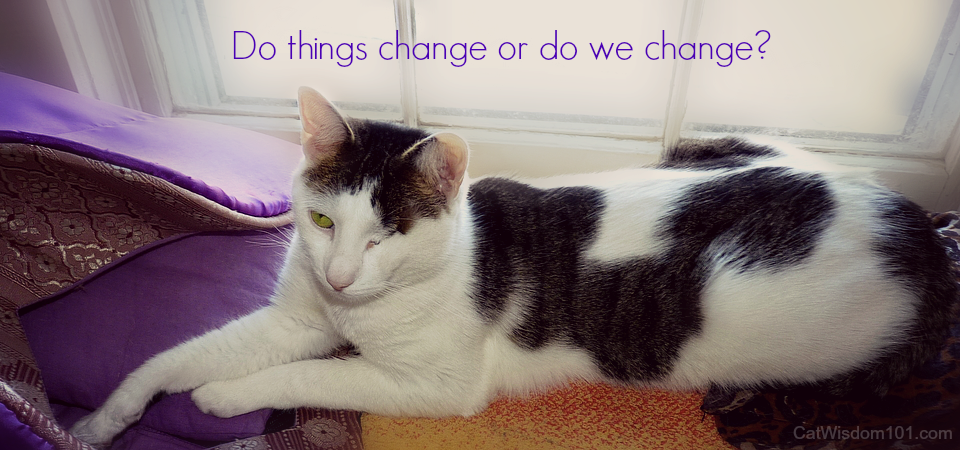Vet 101: In The Pink
 Odin (and his back lit pink ears) is our model today for Vet 101 with our vet, Dr. Rich Goldstein’s Q & A: In the Pink.
Odin (and his back lit pink ears) is our model today for Vet 101 with our vet, Dr. Rich Goldstein’s Q & A: In the Pink.
Q: Summer is already here in North Carolina. Are there any health concerns for my mostly white kitten (pink nose) and sunburn? If I put some ointment or something one, wouldn’t she just lick it off?
A:Ah, those lazy, hazy, crazy days of summer. Relaxing in the sun, frolicking with your friends, not a care in the world. Not a bad life for a human… or a cat! Just like their people, cats can also be sensitive to prolonged sun exposure. Remember when we used to douse ourselves in Crisco and sit in the sun for hours? Bad, bad, bad!!! Today we understand the importance of protecting ourselves from the sun.
But how can we protect our cats from the harmful effects of the sun?
Any animal exposed to the sun’s rays has an increased risk of sunburn, hypersensitivity reactions, and skin cancer. Cats that are white, have thin coats, are shaved, have exposed areas of skin, or are fair-skinned, have an even greater risk of developing sun-related problems. The best method of protection is avoidance. Try to keep Kitty inside on bright sunny days, especially between peak sun hours (10am – 2pm). (But also be aware that on hazy and overcast days, the sun’s rays can still get through the clouds and cause sunburn!) If your cat goes outside, make sure there are plenty of shady spots to cool off and avoid the sun. A sheltered area – even a cat house – with an ample supply of fresh water is a great escape.
As for sunscreens, there are no completely pet-safe, FDA approved products available for cats. Some human products may be effective. BUT, you must make sure that the following toxic ingredients are NOT found in the sunscreen: PABA, zinc, fragrance, propylene glycol, and salicylates (including octyl salicylate, homosalate, ethylhexyl salicylate). Sprays-on sunscreens can be toxic to the respiratory system. That eliminates most products!
Sunscreen ointments that are safe for children, are non-staining, and contain titanium dioxide are considered safer for use on ear tips and “non-lickable” exposed areas of cats. But remember, as fastidious groomers, cats are usually loathe to have anything “weird” on their fur or skin, and will try their hardest to lick it off. Even homeopathic remedies can be toxic to cats if put on areas that the cat can lick and ingest. If sunscreen is used, you need to use “plenty”, and reapply every 4-6 hours.
The nose is certainly a tricky, but important place, to protect, especially if it’s pink or non-pigmented. Telling a cat not to lick something off its nose, however, is generally an unrewarding experience. You can try to find a way to distract her attention for a few minutes until the sunscreen is absorbed into the skin – perhaps by playing with a favorite toy, or feeding treats. But you’d have to find the cat and do that every 4 -6 hours all summer long to be successful. Good luck with that.
So, with a long summer ahead of you, better to explain to kitty that he should stay out of the sun during peak sun hours for his own good…which is good advice for all of us.
Editor’s note: Odin is a prime candidate for sunscreen. Good thing Dr. G. will be visiting us tomorrow. Have a question for our dear doctor? Send it to Layla@laylamorganwilde.com with Vet 101 in the subject line.






10 Comments
Hairless Cat Girl
Hi Layla and Dr. G.,
Cat’s noses are quite vulnerable to sunburn. We’ve had white cats in the past and they do get a peeling nose if they are in the sun for very long.
Hairless cats are particularly vulnerable to sunburn since they have no fur protection anywhere on their bodies. They are also susceptible to skin cancer due to the rays of the sun.
I’m not at all comfortable putting sunscreen on our cats. I’d rather keep them in the shade while I sit outside with them. I let them wander into the sunlight for a few minutes but no longer than that.
=^-^= Hairless Cat Girl =^-^=
Glogirly & Katie
This is very helpful! ….we would have never even thought of sun damage or sunscreen! But it makes complete sense, especially with those pink noses!
; ) Katie & Glogirly
Oui Oui
In our area, its best just to stay in. Not only is too much sun bad, but there are lots of cars and even coyotes, if you can believe it! We live between Washington DC & Baltimore. Not only have county officials sent warnings out on how to keep pets safe, the mom has seen them twice.
Kathy Thompson
Oh bother…another worry for poor little kitties. We hope all kitties have somewhere to get out of the sun. Thanks again for another wonderfully informative spot! Luvs Skeeter and Izzy
>^@@^< gotta wear the shades to be cool catz
Abby
Oh dear we hope all light nosed kitties stay safe.
We are all either dark nosed or have black noses and we never get outside.
purrs
>^,,^<
♥Abby♥Boo♥Ping♥Jinx♥Grace♥
CATachresis
Sun??? Hmmmm! Must google it and find out what it is??
Julia Williams
That is such a beautiful photo of Odin, and I love the backlit pink ears. And what an informative post this is. I have been keeping my kitties indoors more and more, and I also find that during the hottest part of the day they usually want to nap indoors anyway. White kitties are esp. at risk for sunburn though.
Lisa Richman
We agree that the best prevention is avoidance! Surprisingly, when CJ was burned so badly, we were told by the emergency vet that he could be impacted by the sun’s rays even inside the house, through the window glass!
Glass naturally blocks some but not all UV rays. So he recommended CJ wear sunscreen when enjoying subpuddles inside the home, too. Of course, CJ’s situation is an unusual one, as he has exposed skin that is healed from burns where fur will not regrow.
Still, we were disconcerted that there are no perfectly safe sunscreens for kitties. Titanium dioxide is the best solution – but then we read this! EEK! “The titanium dioxide particles used in sunscreens have to be coated with silica or alumina, because titanium dioxide creates radicals in the photocatalytic reaction. These radicals are carcinogenic, and could damage the skin.” (from wikipedia)
Brian
agood info for those heading outdoors fur sure!
Tamago
It is a very helpful information about sunscreen and how to apply it. If I use it on my kids, definitely need to distract until absorbed..one of my them really really hates anything unusual on his fur or skin.
I love the photo..very beautiful!